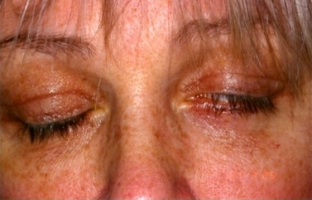A person's eyes always sparkle, and this does not depend on the lighting or the level of the "hormone of happiness"; in blood. Anatomically, human eyes are arranged in such a way that natural mechanisms of protection against harmful environmental factors work in them. The eye must be constantly moistened, otherwise it cannot function normally. Blink – This is the physiological process of closing the eyelids, during which the mucous membrane of the eyes is moistened. Violation of the process of moisturizing the eyeball threatens to dry out its surface and the development of dangerous diseases. One of the pathologies leading to dry eyes is lagophthalmos – incomplete closure of the eyelids.
Causes and treatments for lagophthalmos
If a person's eyelids close completely and correctly, and the blinking process occurs fully – the cornea of the eye remains hydrated and the eye itself is always protected. With lagophthalmos, as a result of the influence of certain factors, the process of complete closure of the eyelids is disrupted, as a result of which the integrity of the tear film is violated, and pathological changes in the conjunctiva and cornea occur. A feature of this disease is that a person cannot completely close the palpebral fissure even in a dream. That is why lagophthalmos is otherwise called "hare's eye". An effective treatment for lagophthalmos is surgery.
Lagophthalmos:
- etiology of lagophthalmos: why the eyelids do not close completely;
- clinical picture of lagophthalmos: characteristic symptoms;
- an effective treatment for lagophthalmos – surgery.
Etiology of lagophthalmos: why the eyelids do not close completely
A number of reasons can lead to the development of lagophthalmos, the main of which are:
- a congenital pathology in which the eyelids are too short and complete closure of the palpebral fissure is anatomically impossible;
- mechanical damage to the eyes as a result of injuries or surgical interventions, after which there is an eversion or inversion of the eyelids;
- exophthalmos or protrusion of the eyeball as a result of a malfunction of the thyroid gland or pressure on the eyeball by a growing tumor formation;
- symblepharon – increment of the eyelid to the conjunctiva of the eyeball;
- facial paralysis.
Clinical picture of lagophthalmos: characteristic symptoms
The clinical picture of lagophthalmos is very characteristic, and diagnosing the disease is quite simple: when you try to close your eyelids, this process does not occur completely. In addition, the patient is concerned about redness of the eyes, dryness, burning and sensation of a foreign body in the eyes, photophobia, sometimes pain in the eyes, blurring and blurred vision. Depending on the cause of lagophthalmos, symptoms such as eyelid lag behind the eyeball, lacrimation, and so on can be observed. Over time, the pathological process is aggravated, erosion and ulceration of the cornea occurs, and its clouding may be observed. Lagoftalmos – this is a condition that requires immediate treatment.

Effective treatment for lagophthalmos – surgery
Conservative treatment of lagophthalmos is carried out at the onset of the disease, in order to sufficiently moisturize the cornea. To do this, special drops with antiseptic properties are instilled into the eyes. But the only effective treatment for lagophthalmos is surgery. The operation procedure is as follows: a relaxing incision is made 8 mm above the edge of the upper eyelid, which is extended by several millimeters to the inner and outer corners of the eye. The resulting defect is closed with a graft taken from the behind the ear, scalp, back of the neck or the medial surface of the forearm and shoulder. The graft is fixed with interrupted sutures and a special fixing bandage, which is removed after 5 days.







Add a comment